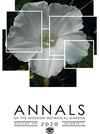The Quinquín Sedges: Taxonomy of the Carex phleoides Group (Cyperaceae)1
IF 1.3
3区 生物学
Q3 PLANT SCIENCES
引用次数: 1
Abstract
Abstract Carex phleoides Cav. is the largest species of the former genus Uncinia Pers. It is widely distributed in the Neotropics and is also known from the Juan Fernández archipelago off the coast of Chile. A second taxon, U. trichocarpa C. A. Mey., is often considered a synonym of C. phleoides, but also sometimes a variety of that species or even a distinct species. We performed a morphometric study using representative material covering the entire distribution and morphological variation of C. phleoides s.l. to clarify its taxonomy. Our analyses revealed that U. trichocarpa is distinct from C. phleoides. Accordingly, we coined the name C. quinquin Jim.-Mejías & Dorr to accommodate this species under Carex L. because combinations of other available names are all blocked. Carex phleoides displayed two extremes of variation with geographical correspondence, a southern form in the Southern Cone north to Bolivia, and a northern one ranging from Bolivia to Mexico. We propose to recognize two subspecies within C. phleoides, the nominate subspecies being the southern one, and the northern one based on the epithet koyamae. Plants from the Juan Fernández archipelago were shown to be morphologically intermediate with the endemic C. plurinervata J. R. Starr, a result that might point to introgression between these two species. We selected lectotypes for nine names, including two of the accepted ones, as well as their synonyms.Quinquín莎草:苔属(苏科)的分类
摘要苔草。是前钩藤属中最大的一种。它广泛分布在新热带地区,也为智利海岸外的胡安·费尔南德斯群岛所知。第二个分类单元,毛果木霉C.A.Mey。,通常被认为是C.phleoides的同义词,但有时也是该物种的一个变种,甚至是一个独特的物种。我们使用代表性材料进行了形态计量学研究,涵盖了C.phleoides s.l.的整个分布和形态变异,以阐明其分类学。我们的分析表明,毛果球藻与花球藻是不同的。因此,我们创造了C.quiquin Jim这个名字-Mejías&Dorr将该物种归入Carex L.之下,因为其他可用名称的组合都被阻止了。苔草在地理对应方面表现出两个极端的变化,一个是南锥体以北到玻利维亚的南部形式,另一个是从玻利维亚到墨西哥的北部形式。我们建议在C.phleoides中识别两个亚种,提名的亚种是南部的,而北部的亚种是基于koyamae的。Juan Fernández群岛的植物在形态上与当地的多神经C.R.Starr是中间的,这一结果可能表明这两个物种之间存在渗入。我们为九个名字选择了选型,其中包括两个已被接受的名字,以及它们的同义词。
本文章由计算机程序翻译,如有差异,请以英文原文为准。
求助全文
约1分钟内获得全文
求助全文
来源期刊
CiteScore
3.60
自引率
0.00%
发文量
15
期刊介绍:
The Annals of the Missouri Botanical Garden is a quarterly international journal primarily devoted to systematic botany and evolutionary biology. We encourage submissions of original papers dealing with significant advances in the taxonomy, phylogeny, biogeography, paleobiology, and evolution of plants, and in conservation genetics and biology, restoration ecology, and ethnobiology, using morphological and/or molecular characters, field observations, and/or database information. We also welcome reviews and papers on conceptual issues and new methodologies in systematics. Important floristic works will also be considered. Symposium proceedings discussing a broader range of topical biological subjects are also published, typically once a year. All manuscripts are peer-reviewed by qualified and independent reviewers.

 求助内容:
求助内容: 应助结果提醒方式:
应助结果提醒方式:


